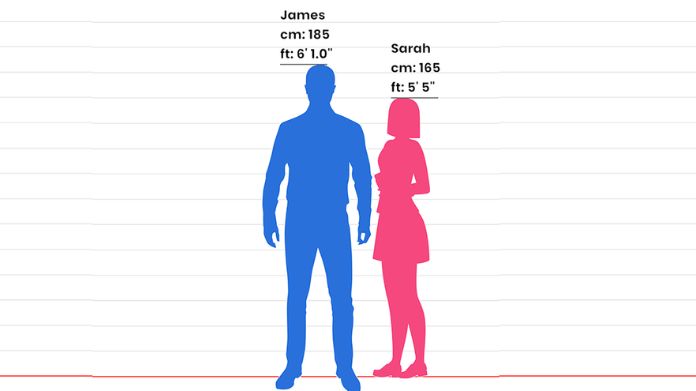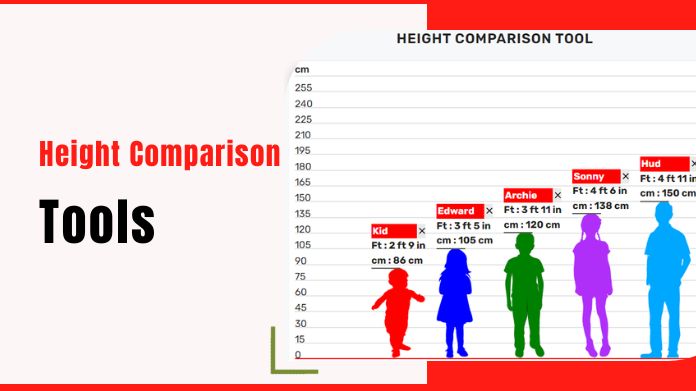Human stature is a distinctive marker of individual differences in a world where diversity extends beyond cultural backgrounds and professions.
Height, a fundamental anthropometric measure, reflects genetic and environmental influences and shapes perceptions and experiences. Height comparison, an engaging exploration into the vertical spectrum, unveils the significance of relative statures.
This height comparison guide navigates the intricacies of height comparison, shedding light on its methodologies, the evolution of visual aids, and the key player in this exploration—the Height Comparison Chart.
Join us on a journey through the visual landscape of heights, where charts become windows into the diverse tapestry of human dimensions.
Understanding Height as a Measure
Understanding height as a measure requires considering various factors. First, it is essential to clarify the specific definition of height. In most cases, height refers to the vertical distance from the base to the top of an object or individual.
Using units such as feet, inches, or centimeters is common when measuring human height. However, ensuring consistency in units to compare heights accurately is crucial. For example, if one person’s height is measured in feet and another is measured in centimeters, a conversion must be done to make meaningful comparisons.
Additionally, understanding height requires considering the context in which it is being measured. For instance, when calculating the height of a building, it is essential to determine whether it includes only the structure or any antennas or spires that extend beyond the central part of the building.
Furthermore, height can be influenced by various factors such as posture, footwear, and time of day. Therefore, it is crucial to standardize these factors as much as possible to obtain accurate measurements.
What is Height Comparison?

It is measuring and comparing the heights of different objects or individuals. It is used to determine the relative heights or differences in height between two or more things.
This can be done by directly measuring the heights using a measuring tool such as tape, ruler, or visual estimation techniques.
It is often used in various fields, such as architecture, engineering, sports, and human biology, to gather data and compare for multiple purposes.
Methodologies in Height Comparison
Several methodologies are employed for height comparison. Each approach provides unique insights, from the classic side-by-side visual representation to statistical analyses.
Height Comparison Charts often categorize individuals by profession, historical era, or fictional universes, enabling viewers to grasp the diversity of heights within specific contexts.
Height Comparison in Popular Culture
It’s have found a home in popular culture, where fans eagerly explore the relative statures of their favourite characters. Whether it’s superheroes, movie stars, or characters from literature, Height Comparison Charts add an extra layer of understanding and engagement, fostering a sense of connection with the characters.
Height Comparison Across Professions
Professions often exhibit height trends, influenced by the requirements of the job or industry stereotypes. Comparing the heights of individuals within specific careers can uncover patterns and challenge preconceived notions. Height Comparison Charts become tools for breaking down stereotypes and promoting inclusivity.
Digital Interactive Height Comparison Tools

Digital interactive height comparison tools are becoming increasingly popular in today’s technology-driven world. These tools allow users to compare their height with others fun and engagingly.
One of the benefits of these tools is their accuracy. By inputting your height into the tool, it can accurately represent how you compare to others. This can be particularly useful when height plays a significant role in sports or modelling.
Another advantage of these tools is their accessibility. Many digital platforms offer height comparison tools that can be accessed from different devices, including smartphones, tablets, and computers.
This means that users can easily access and utilise these tools whenever and wherever they want. In addition to accuracy and accessibility, digital interactive height comparison tools offer customization options.
Users can often personalize their experience by choosing different units of measurement, adjusting the scale, or even selecting other avatars to represent themselves and the individuals they are comparing their height to.
While these tools can be entertaining and informative, it’s important to remember that height is just one aspect of a person’s overall appearance and identity. It should not be used as the sole determinant of someone’s worth or abilities.
Digital interactive height comparison tools are a fun and engaging way to compare heights. They offer accuracy, accessibility, and customization options, making them a popular choice for many individuals.
However, it’s important to remember that height is just one aspect of a person’s individuality and should not be used to judge or discriminate against others.
Challenges in Height Comparison
While it offers valuable insights, it comes with challenges. Inaccurate data, cultural biases, and measurement standard variations can impact the reliability of height comparisons.
Navigating these challenges requires a discerning approach to ensure the charts provide meaningful and accurate information.
Conclusion
As we explore the world of it and the visual wonders of Height Comparison Charts, embracing the diversity that makes each individual unique is essential.
Whether used for scientific research, cultural analysis, or pure curiosity, Height Comparison Charts offer a lens through which to appreciate the variations in human stature, fostering a greater understanding of the intricacies that shape our perceptions of height.
It transcends the mere measurement of physical dimensions; it’s a journey into the nuances of diversity, an exploration of societal norms, and a celebration of individuality.
Through Height Comparison Charts, we gain a visual appreciation for height and a deeper understanding of the multifaceted ways in which height influences our lives and perceptions.






